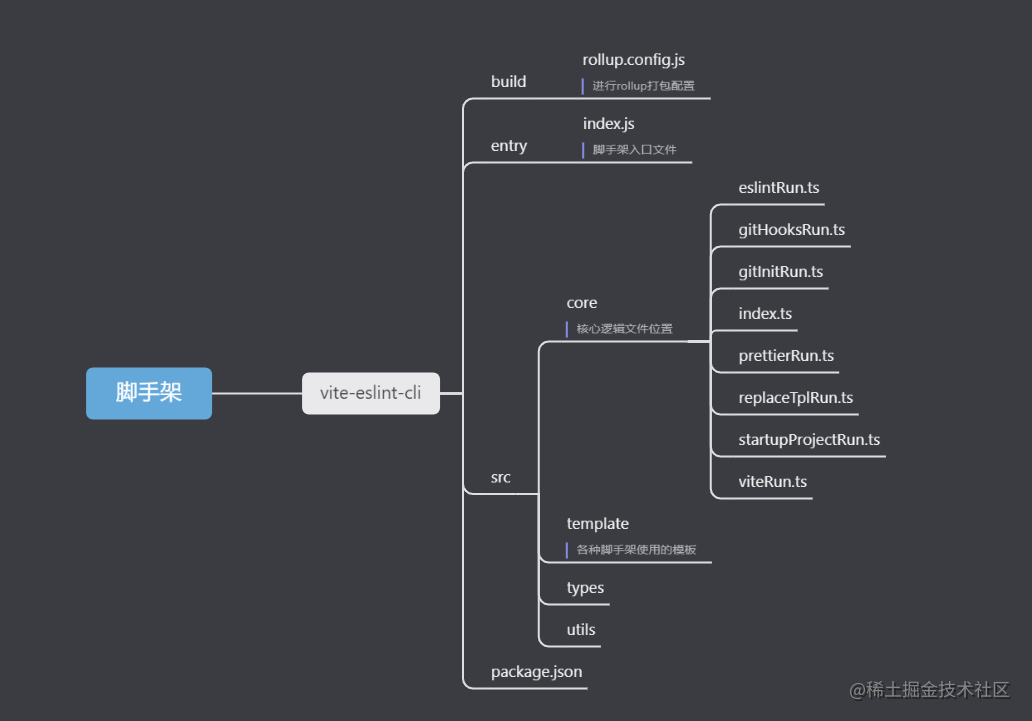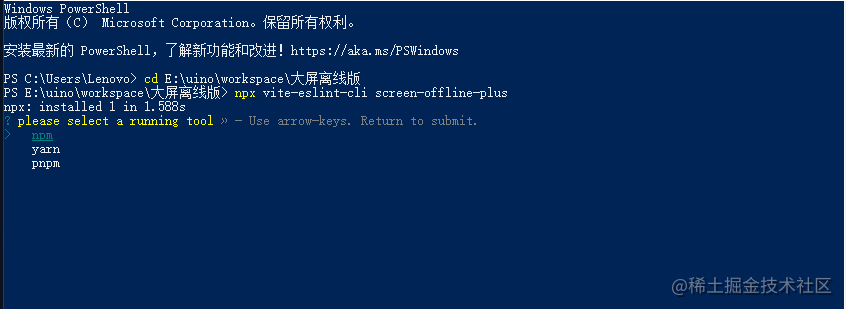前言
这里让我来教大家如何可以从0到1做一个自己的脚手架,vite-eslint-cli为例进行实现,看看我们需要经过哪些步骤呢???
关于vite-eslint-cli
1. 这个脚手架能干什么
- 💡 基于vite 实现了项目以及规范一体化部署
- ⚡️可以从0 到 1快速部署
- 🛠️ 内置实现vue3/ ts/ eslint/ prettier/ commitlint/ husky/ pinia持久化/ vue-router
- 📦 可以快速实现从代码以及规范的搭建
2. 跟vite有什么不同呢
- 💡 内置vite 创建方式,和单独使用vite没有什么不同
- ⚡️ 内置了eslint规范,例如:prettier, eslint, commitlint, husky
- 🛠️ 提供了vue3 的全家桶配置。例如: pinia, pinia-plugin-persist, vue-router
- 📦 提供了pinia 持久化方案
- 🔩 内置了vue-router以及pinia 案例
- 🔑 可以用–template 参数 来替代vite --template参数
3. 去哪里看呢
4. 效果呢
- 效果的话,先不给大家演示了。铁子们可以自己运行
npx vite-eslint-cli myapp --template vue-ts。看下具体的效果。广告时间到此结束,我们要正式进入主题了
从0到1进行实现
1. 用到哪些包呢,这里我们进行简单介绍下
- commander 执行命令的包
- colors 可以在控制台打印不同颜色log的包,主要是为了美观用
- prompts 进行命令行交互的包
- fs-extra 进行fs相关控制的包
- … 还有rollup 以及ts配置的包。更多的信息参照下GitHub源码就行了
2. 目录结构是怎样的呢???

上述是大概的文件目录,更加详细的目录可以参照GitHub中的源码,同时各位也可以建立自己目录。都是ok的
3. 从哪里开始呢???
注意:相对目录都是相对于根目录而言的
1. 建立专属的rollup配置
我们整个脚手架使用ts来写的,原则上将ts转换为js就可以了。不过具体还是看各位的配置。接下来我粘贴出自己的打包配置文件
文件位置:build/rollup.config.js
const path = require('path')
const { nodeResolve } = require('@rollup/plugin-node-resolve')
const commonjs = require('@rollup/plugin-commonjs')
const typescript = require('rollup-plugin-typescript2')
const json = require('@rollup/plugin-json')
const del = require('rollup-plugin-delete')
const resolvePath = url => path.resolve(__dirname, url)
const copy = require('rollup-plugin-copy')
module.exports = {
input: resolvePath('../src/index.ts'),
output: {
file: resolvePath('../dist/index.js'),
format: 'cjs'
},
plugins: [
del({
targets: 'dist/*'
}),
typescript({
exclude: ['node_modules'],
cwd: resolvePath('../')
}),
commonjs(),
nodeResolve(),
json(),
copy({
targets: [
{ src: 'src/template', dest: 'dist/' }
]
})
]
}
2. 脚手架入口
文件位置:package.json
- bin 就是我们脚手架执行的入口,其中的名称
vite-eslint-cli. 我们可以在命令行中运行开始执行我们的脚手架- 如果项目还没发布到npm上,可以通过运行
npm link来全局链接,再次执行vite-eslint-cli来运行
- 如果项目还没发布到npm上,可以通过运行
{
"name": "vite-eslint-cli",
"version": "1.0.1",
"description": "基于vite + vue3/ vite + react等, 实现eslint prettier部署,内置vite vue3运行方式,执行代码构建以及eslint部署一体. 内置(pinia,vue-router等)",
"bin": {
"vite-eslint-cli": "entry/index.js"
},
"scripts": {
"build": "rollup -c build/rollup.config.js"
},
"files": [
"dist",
"entry"
],
"keywords": [
"rollup",
"vue3",
"react",
"eslint",
"commitlint",
"prettier"
],
"repository": {
"type": "git",
"url": "https://github.com/a572251465/vite-eslint-cli.git"
},
"bugs": {
"url": "https://github.com/a572251465/vite-eslint-cli/issues"
},
"homepage": "https://github.com/a572251465/vite-eslint-cli",
"author": "lihaohao",
"license": "MIT",
"devDependencies": {
"@rollup/plugin-commonjs": "^21.0.2",
"@rollup/plugin-json": "^4.1.0",
"@rollup/plugin-node-resolve": "^13.1.3",
"@types/commander": "^2.12.2",
"@types/node": "^17.0.21",
"@types/prompts": "^2.0.14",
"colors": "^1.4.0",
"commander": "^9.0.0",
"eslint": "^8.10.0",
"fs-extra": "^10.0.1",
"prettier": "^2.5.1",
"prompts": "^2.4.2",
"rollup": "^2.69.0",
"rollup-plugin-copy": "^3.4.0",
"rollup-plugin-delete": "^2.0.0",
"rollup-plugin-typescript2": "^0.31.2",
"tslib": "^2.3.1",
"typescript": "^4.6.2"
}
}
3. node执行入口文件
文件位置:entry/index.js
#! /usr/bin/env node
require('../dist/index')
这个地址会指向打包后的index.js,真正的入口文件是打包前的ts。可以通过rollup配置来看
4. 编写代码入口文件。
几乎所有的脚手架都会让你选择各种选项,选择通过后进行命令创建,这个脚手架也不例外。看下图:

- 通过上图我们就可以得知,首先我们会进入交互命令模式,经过我们的一通选择后,才可以创建项目。那我们就看来看下具体的代码:
- 我们使用插件
commander来执行npx vite-eslint-cli my-app - 上述的代码执行后,可以选择执行工具,这个效果我们其实是通过
prompts插件来实现的 - 接下来看下 源码的实现逻辑
- 我们使用插件
/**
* @author lihh
* @description 执行commander入口
*/
import { Command } from 'commander'
import { getCommanderOptions, getConfigFile } from './utils'
import { ICmdOptions, IExecOptions } from './types'
import prompts from 'prompts'
import run from './core'
const path = require('path')
/**
* @author lihh
* @description 表示闻讯函数
* @param tpl 表示模板
*/
const promptHandle = async (tpl: string) => {
let baseOptions = [{
type: 'select',
name: 'tool',
message: 'please select a running tool',
choices: ['npm', 'yarn', 'pnpm'].map(item => ({ title: item, value: item }))
}] as prompts.PromptObject[]
const res = await prompts(baseOptions)
return { ...res, isPinia: true, isVueRouter: true }
}
const program = new Command()
// 获取package 文件配置信息
const configInfo = getConfigFile()
// 获取commander options 配置信息
const commanderOptions = getCommanderOptions()
program
.name(configInfo.name)
.description(configInfo.description)
.version(configInfo.version)
program.argument('<project-name>', 'Please enter the project name ')
commanderOptions.forEach(item => {
program.option(item.keyword, item.description)
})
program.action(async (projectName: string) => {
const params = program.opts() as ICmdOptions
// 是否快速创建
const isY = params.y || false
// 表示使用模板
const tpl = isY ? 'vue-ts' : params.template || 'vue-ts'
// 选择执行工具
const tool = await promptHandle(tpl)
const rootPath = process.cwd()
const projectPath = path.resolve(rootPath, projectName)
const options = { tpl, ...tool, rootPath, projectName, projectPath } as IExecOptions
// 开始运行命令
await run(options)
})
program.parse()
上述代码中的run函数 其实就是我们程序的入口
5. 梳理下主要执行的逻辑
-
- 实现内置的vite初始化,我们对应的是
viteRun.ts文件。 其实我们的工具也是内置vite,运行vite后生成出基本的结构,在这个结构上进行改造
- 实现内置的vite初始化,我们对应的是
-
- 进行git init处理。对应的是
gitInitRun.ts文件。 其实这个逻辑很简单就是执行命令行git init。 因为我们后面的git hook,commitlint都是基于.git文件的
- 进行git init处理。对应的是
-
- 执行eslint相关的配置。对应的是
eslintRun.ts。其中主要是负责一些eslint相关配置安装以及一些忽略文件编写等。就是eslint相关的处理都在这里进行
- 执行eslint相关的配置。对应的是
-
- 执行prettier相关配置。对应的是
prettierRun.ts文件。跟eslint大致类似
- 执行prettier相关配置。对应的是
-
- 执行git hook相关配置。对应的是
gitHooksRun.ts文件。主要是负责一些提交规范相关的内容。例如:commitlint等
- 执行git hook相关配置。对应的是
-
- 执行替换模板配置。对应的是
replaceTplRun.ts文件, 主要是将准备好的模板对原生vue项目模板进行替换。就是启动项目后可以是自己想要的页面
- 执行替换模板配置。对应的是
-
- 下面我会解释下主要是的文件,上述提到的文件各位可以自己编写或是看源码也行。
6. 控制流程的核心文件
import { IExecOptions } from '../types'
import viteRun from './viteRun'
import gitInitRun from './gitInitRun'
import { successLog } from '../utils'
import eslintRun from './eslintRun'
import prettierRun from './prettierRun'
import gitHooksRun from './gitHooksRun'
import startupProjectRun from './startupProjectRun'
import replaceTplRun from './replaceTplRun'
const execStacks = [viteRun, gitInitRun, eslintRun, prettierRun, gitHooksRun, replaceTplRun]
/**
* @author lihh
* @description 开始执行命令
* @param options 通过shell 以及入口 收集的参数
*/
const run = async (options: IExecOptions) => {
const len = execStacks.length
// 表示成功的回调
async function success() {
successLog(`end: Project initialization succeeded`)
// 启动后置钩子
await startupProjectRun.apply(options)
}
async function next(index: number) {
const instance = execStacks[index]
await instance.apply({
...options, callback: async (flags?: string) => {
const currentIndex = index + 1
// 如果flags存在值 表示cli中途中断
if (currentIndex === len || (flags && flags === 'end')) {
await success()
} else {
await next(currentIndex)
}
}
})
}
await next(0)
}
export default run
简单解释下上述的代码
- 我们需要执行的每个文件(viteRun.ts等)都是一个类,类中必须包含apply方法。这个函数是类执行的入口
- 我们会将所有需要执行的文件都放到一个数组中,按想要的执行的顺序存放。通过
next函数依次进行调用,通过参数callback函数来通知下一个文件执行,直到最后结束。
结束
脚手架中核心的内容我都解释到了。如果对各位有帮助的话,也请各位老铁给个star,如果还有疑问可以直接issue我。






















 2万+
2万+











 被折叠的 条评论
为什么被折叠?
被折叠的 条评论
为什么被折叠?








